Business Environment Report: Metro Bank - Organisational Analysis
VerifiedAdded on 2021/02/20
|16
|4346
|39
Report
AI Summary
This report provides a comprehensive analysis of Metro Bank's business environment, examining various aspects of its operations. It begins by defining the business environment and its dynamic nature, followed by an introduction to Metro Bank, its founding, and scope. The report then delves into different types of business organizations, including private, public, and voluntary sectors, providing examples like Metro Bank, NHS, and Wellcome Trust. It explores the size and scope of these organizations, linking them to their business objectives. The report further investigates the interrelationships between organizational functions such as marketing, HR, and finance, analyzing their advantages and disadvantages. A critical analysis of business structures and their complexities is presented, along with PESTLE analysis and an examination of internal and external factors influencing decision-making. The report concludes with an evaluation of the impacts of macro and micro factors on the business, providing a detailed overview of Metro Bank's environment and operations.

Business
Environment
Environment
Paraphrase This Document
Need a fresh take? Get an instant paraphrase of this document with our AI Paraphraser
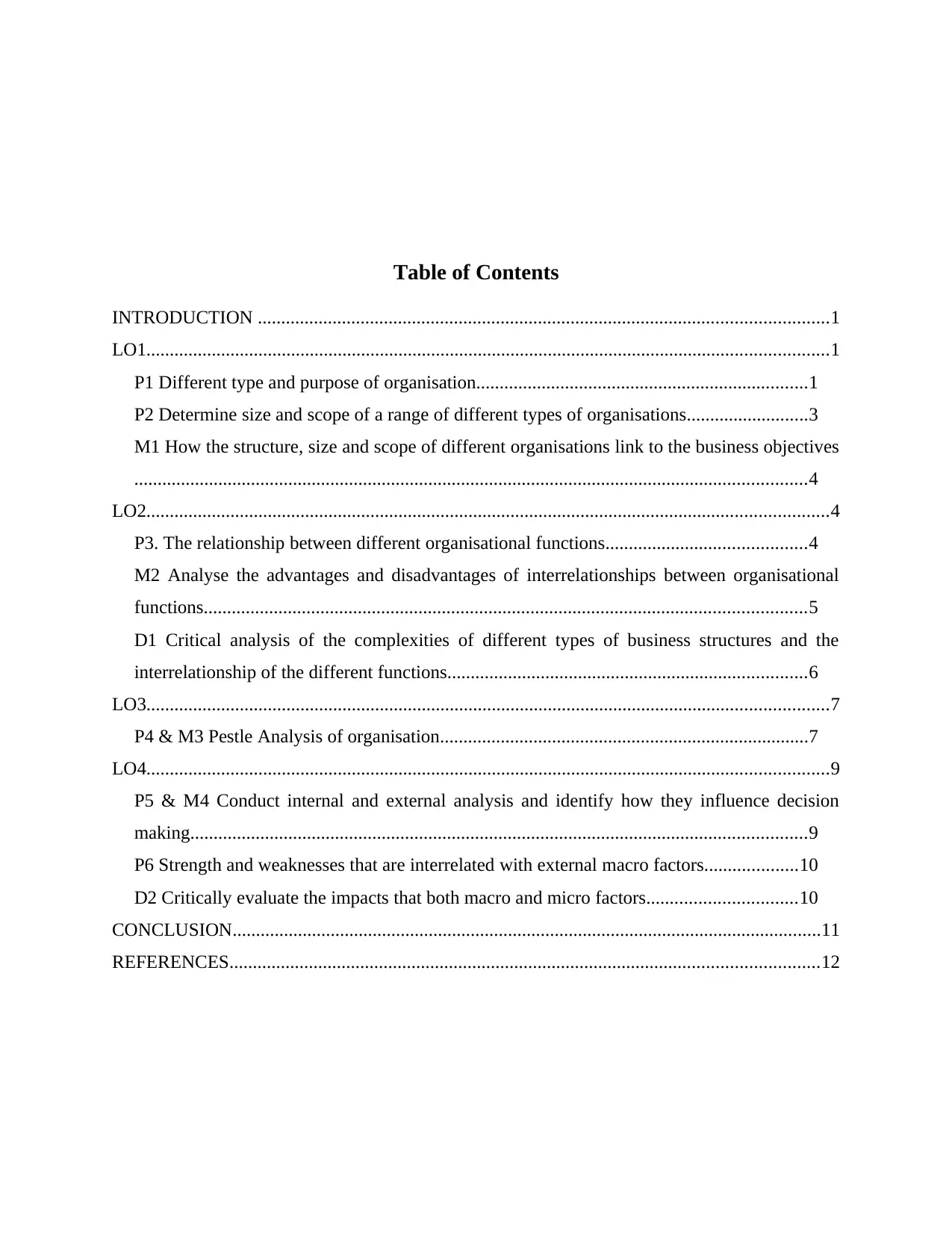
Table of Contents
INTRODUCTION ..........................................................................................................................1
LO1..................................................................................................................................................1
P1 Different type and purpose of organisation.......................................................................1
P2 Determine size and scope of a range of different types of organisations..........................3
M1 How the structure, size and scope of different organisations link to the business objectives
................................................................................................................................................4
LO2..................................................................................................................................................4
P3. The relationship between different organisational functions...........................................4
M2 Analyse the advantages and disadvantages of interrelationships between organisational
functions.................................................................................................................................5
D1 Critical analysis of the complexities of different types of business structures and the
interrelationship of the different functions.............................................................................6
LO3..................................................................................................................................................7
P4 & M3 Pestle Analysis of organisation...............................................................................7
LO4..................................................................................................................................................9
P5 & M4 Conduct internal and external analysis and identify how they influence decision
making....................................................................................................................................9
P6 Strength and weaknesses that are interrelated with external macro factors....................10
D2 Critically evaluate the impacts that both macro and micro factors................................10
CONCLUSION..............................................................................................................................11
REFERENCES..............................................................................................................................12
INTRODUCTION ..........................................................................................................................1
LO1..................................................................................................................................................1
P1 Different type and purpose of organisation.......................................................................1
P2 Determine size and scope of a range of different types of organisations..........................3
M1 How the structure, size and scope of different organisations link to the business objectives
................................................................................................................................................4
LO2..................................................................................................................................................4
P3. The relationship between different organisational functions...........................................4
M2 Analyse the advantages and disadvantages of interrelationships between organisational
functions.................................................................................................................................5
D1 Critical analysis of the complexities of different types of business structures and the
interrelationship of the different functions.............................................................................6
LO3..................................................................................................................................................7
P4 & M3 Pestle Analysis of organisation...............................................................................7
LO4..................................................................................................................................................9
P5 & M4 Conduct internal and external analysis and identify how they influence decision
making....................................................................................................................................9
P6 Strength and weaknesses that are interrelated with external macro factors....................10
D2 Critically evaluate the impacts that both macro and micro factors................................10
CONCLUSION..............................................................................................................................11
REFERENCES..............................................................................................................................12
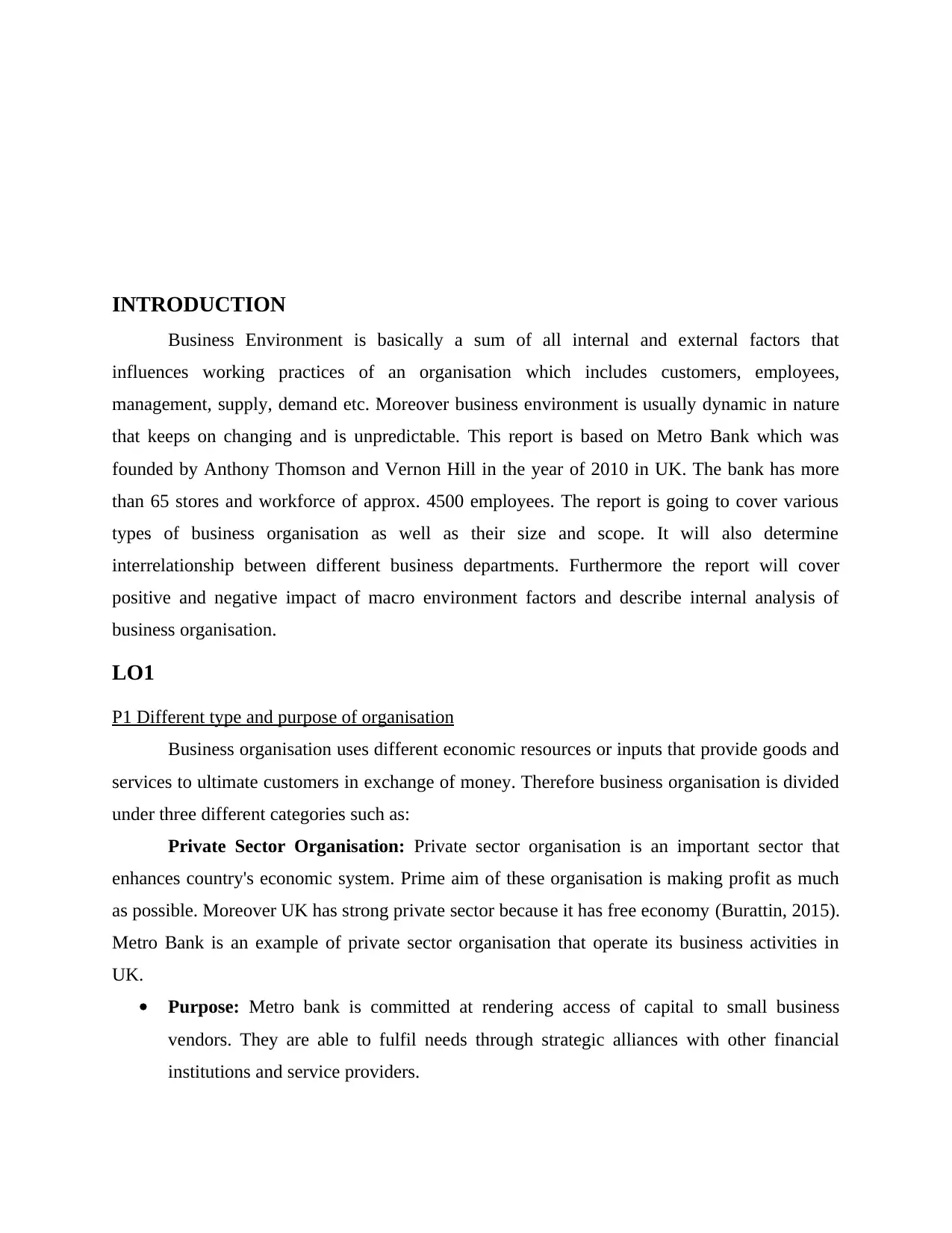
INTRODUCTION
Business Environment is basically a sum of all internal and external factors that
influences working practices of an organisation which includes customers, employees,
management, supply, demand etc. Moreover business environment is usually dynamic in nature
that keeps on changing and is unpredictable. This report is based on Metro Bank which was
founded by Anthony Thomson and Vernon Hill in the year of 2010 in UK. The bank has more
than 65 stores and workforce of approx. 4500 employees. The report is going to cover various
types of business organisation as well as their size and scope. It will also determine
interrelationship between different business departments. Furthermore the report will cover
positive and negative impact of macro environment factors and describe internal analysis of
business organisation.
LO1
P1 Different type and purpose of organisation
Business organisation uses different economic resources or inputs that provide goods and
services to ultimate customers in exchange of money. Therefore business organisation is divided
under three different categories such as:
Private Sector Organisation: Private sector organisation is an important sector that
enhances country's economic system. Prime aim of these organisation is making profit as much
as possible. Moreover UK has strong private sector because it has free economy (Burattin, 2015).
Metro Bank is an example of private sector organisation that operate its business activities in
UK.
Purpose: Metro bank is committed at rendering access of capital to small business
vendors. They are able to fulfil needs through strategic alliances with other financial
institutions and service providers.
Business Environment is basically a sum of all internal and external factors that
influences working practices of an organisation which includes customers, employees,
management, supply, demand etc. Moreover business environment is usually dynamic in nature
that keeps on changing and is unpredictable. This report is based on Metro Bank which was
founded by Anthony Thomson and Vernon Hill in the year of 2010 in UK. The bank has more
than 65 stores and workforce of approx. 4500 employees. The report is going to cover various
types of business organisation as well as their size and scope. It will also determine
interrelationship between different business departments. Furthermore the report will cover
positive and negative impact of macro environment factors and describe internal analysis of
business organisation.
LO1
P1 Different type and purpose of organisation
Business organisation uses different economic resources or inputs that provide goods and
services to ultimate customers in exchange of money. Therefore business organisation is divided
under three different categories such as:
Private Sector Organisation: Private sector organisation is an important sector that
enhances country's economic system. Prime aim of these organisation is making profit as much
as possible. Moreover UK has strong private sector because it has free economy (Burattin, 2015).
Metro Bank is an example of private sector organisation that operate its business activities in
UK.
Purpose: Metro bank is committed at rendering access of capital to small business
vendors. They are able to fulfil needs through strategic alliances with other financial
institutions and service providers.
⊘ This is a preview!⊘
Do you want full access?
Subscribe today to unlock all pages.

Trusted by 1+ million students worldwide
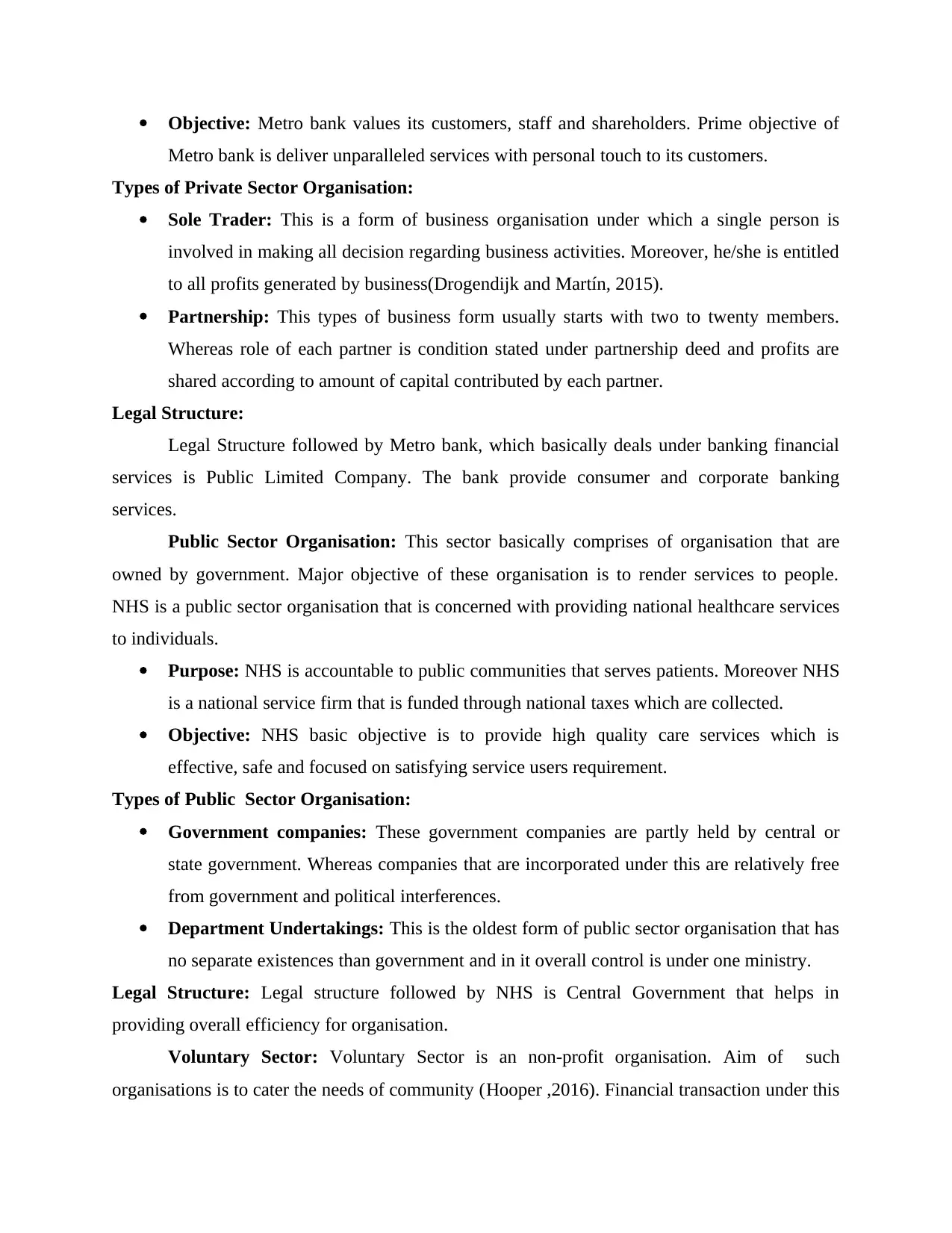
Objective: Metro bank values its customers, staff and shareholders. Prime objective of
Metro bank is deliver unparalleled services with personal touch to its customers.
Types of Private Sector Organisation:
Sole Trader: This is a form of business organisation under which a single person is
involved in making all decision regarding business activities. Moreover, he/she is entitled
to all profits generated by business(Drogendijk and Martín, 2015).
Partnership: This types of business form usually starts with two to twenty members.
Whereas role of each partner is condition stated under partnership deed and profits are
shared according to amount of capital contributed by each partner.
Legal Structure:
Legal Structure followed by Metro bank, which basically deals under banking financial
services is Public Limited Company. The bank provide consumer and corporate banking
services.
Public Sector Organisation: This sector basically comprises of organisation that are
owned by government. Major objective of these organisation is to render services to people.
NHS is a public sector organisation that is concerned with providing national healthcare services
to individuals.
Purpose: NHS is accountable to public communities that serves patients. Moreover NHS
is a national service firm that is funded through national taxes which are collected.
Objective: NHS basic objective is to provide high quality care services which is
effective, safe and focused on satisfying service users requirement.
Types of Public Sector Organisation:
Government companies: These government companies are partly held by central or
state government. Whereas companies that are incorporated under this are relatively free
from government and political interferences.
Department Undertakings: This is the oldest form of public sector organisation that has
no separate existences than government and in it overall control is under one ministry.
Legal Structure: Legal structure followed by NHS is Central Government that helps in
providing overall efficiency for organisation.
Voluntary Sector: Voluntary Sector is an non-profit organisation. Aim of such
organisations is to cater the needs of community (Hooper ,2016). Financial transaction under this
Metro bank is deliver unparalleled services with personal touch to its customers.
Types of Private Sector Organisation:
Sole Trader: This is a form of business organisation under which a single person is
involved in making all decision regarding business activities. Moreover, he/she is entitled
to all profits generated by business(Drogendijk and Martín, 2015).
Partnership: This types of business form usually starts with two to twenty members.
Whereas role of each partner is condition stated under partnership deed and profits are
shared according to amount of capital contributed by each partner.
Legal Structure:
Legal Structure followed by Metro bank, which basically deals under banking financial
services is Public Limited Company. The bank provide consumer and corporate banking
services.
Public Sector Organisation: This sector basically comprises of organisation that are
owned by government. Major objective of these organisation is to render services to people.
NHS is a public sector organisation that is concerned with providing national healthcare services
to individuals.
Purpose: NHS is accountable to public communities that serves patients. Moreover NHS
is a national service firm that is funded through national taxes which are collected.
Objective: NHS basic objective is to provide high quality care services which is
effective, safe and focused on satisfying service users requirement.
Types of Public Sector Organisation:
Government companies: These government companies are partly held by central or
state government. Whereas companies that are incorporated under this are relatively free
from government and political interferences.
Department Undertakings: This is the oldest form of public sector organisation that has
no separate existences than government and in it overall control is under one ministry.
Legal Structure: Legal structure followed by NHS is Central Government that helps in
providing overall efficiency for organisation.
Voluntary Sector: Voluntary Sector is an non-profit organisation. Aim of such
organisations is to cater the needs of community (Hooper ,2016). Financial transaction under this
Paraphrase This Document
Need a fresh take? Get an instant paraphrase of this document with our AI Paraphraser
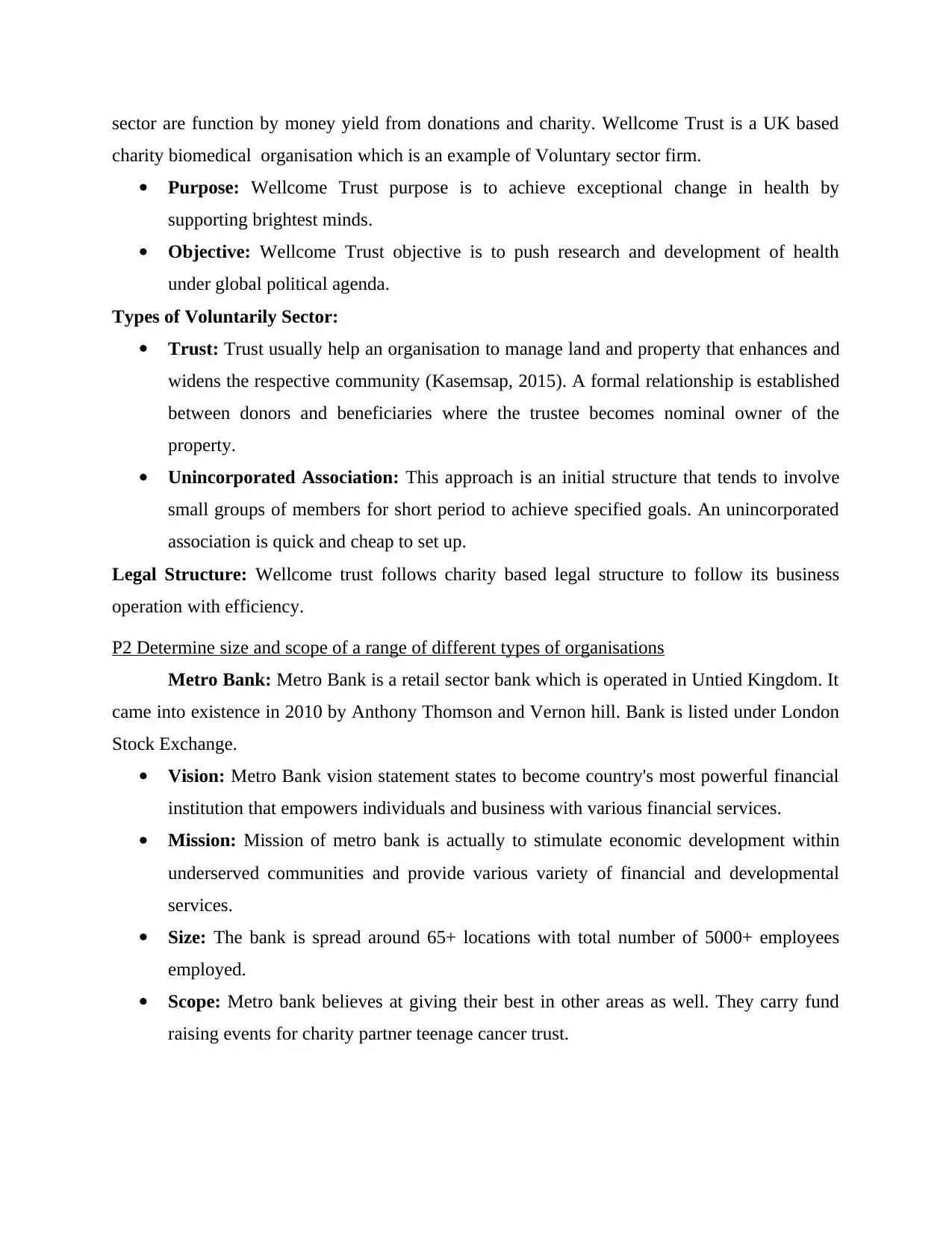
sector are function by money yield from donations and charity. Wellcome Trust is a UK based
charity biomedical organisation which is an example of Voluntary sector firm.
Purpose: Wellcome Trust purpose is to achieve exceptional change in health by
supporting brightest minds.
Objective: Wellcome Trust objective is to push research and development of health
under global political agenda.
Types of Voluntarily Sector:
Trust: Trust usually help an organisation to manage land and property that enhances and
widens the respective community (Kasemsap, 2015). A formal relationship is established
between donors and beneficiaries where the trustee becomes nominal owner of the
property.
Unincorporated Association: This approach is an initial structure that tends to involve
small groups of members for short period to achieve specified goals. An unincorporated
association is quick and cheap to set up.
Legal Structure: Wellcome trust follows charity based legal structure to follow its business
operation with efficiency.
P2 Determine size and scope of a range of different types of organisations
Metro Bank: Metro Bank is a retail sector bank which is operated in Untied Kingdom. It
came into existence in 2010 by Anthony Thomson and Vernon hill. Bank is listed under London
Stock Exchange.
Vision: Metro Bank vision statement states to become country's most powerful financial
institution that empowers individuals and business with various financial services.
Mission: Mission of metro bank is actually to stimulate economic development within
underserved communities and provide various variety of financial and developmental
services.
Size: The bank is spread around 65+ locations with total number of 5000+ employees
employed.
Scope: Metro bank believes at giving their best in other areas as well. They carry fund
raising events for charity partner teenage cancer trust.
charity biomedical organisation which is an example of Voluntary sector firm.
Purpose: Wellcome Trust purpose is to achieve exceptional change in health by
supporting brightest minds.
Objective: Wellcome Trust objective is to push research and development of health
under global political agenda.
Types of Voluntarily Sector:
Trust: Trust usually help an organisation to manage land and property that enhances and
widens the respective community (Kasemsap, 2015). A formal relationship is established
between donors and beneficiaries where the trustee becomes nominal owner of the
property.
Unincorporated Association: This approach is an initial structure that tends to involve
small groups of members for short period to achieve specified goals. An unincorporated
association is quick and cheap to set up.
Legal Structure: Wellcome trust follows charity based legal structure to follow its business
operation with efficiency.
P2 Determine size and scope of a range of different types of organisations
Metro Bank: Metro Bank is a retail sector bank which is operated in Untied Kingdom. It
came into existence in 2010 by Anthony Thomson and Vernon hill. Bank is listed under London
Stock Exchange.
Vision: Metro Bank vision statement states to become country's most powerful financial
institution that empowers individuals and business with various financial services.
Mission: Mission of metro bank is actually to stimulate economic development within
underserved communities and provide various variety of financial and developmental
services.
Size: The bank is spread around 65+ locations with total number of 5000+ employees
employed.
Scope: Metro bank believes at giving their best in other areas as well. They carry fund
raising events for charity partner teenage cancer trust.

NHS: National Health Services came into existence from 1948 which was founded by Aneurin
Bevan (Kasemsap, 2016). NHS provides comprehensive range of healthcare services free at cost
for people living in United Kingdom.
Vision: NHS vision is primarily to deliver better quality of healthcare services to its
clients.
Mission: Mission statement for NHS is basically providing quality care to each and every
person concerned to company.
Size: NHS employees around 1.2 million full time workforce. Company provide care to
patients from 7330 locations.
Scope: NHS is trying cover major part of England and moreover the company under UK
market is trying to expand its business operations.
Wellcome Trust: Wellcome Trust is an independent global charitable foundation based in
London, United Kingdom. Focus of this charitable organisation is basically on biomedical
research services(Kostova and Hult, 2016).
Vision: Vision statement of Wellcome Trust basically deals with contributing overall
development of society by providing effective education and learning facility.
Mission: Wellcome Trust provide high quality research. Moreover it also aims to
develop research and knowledge partnership that enhances to inform health practice,
primarily for low and middle income based countries.
Size: There around 2057 employees working under Wellcome Trust.
Scope: Wellcome Trust aims to achieve extraordinary improvement in healthcare sector
of the world.
M1 How the structure, size and scope of different organisations link to the business objectives
The structure of organisation is always affected with size and scope. It observed that the
actual profitability of an organisation always covers the scope and size because these are the
factors that are actually responsible to attain overall established target of business. However,
larger the size of an organisation the more will be scope to achieve the overall objective of
respective company. Therefore, firm should successfully evaluate each and every task of an
organisation to attain overall desired goals.
Bevan (Kasemsap, 2016). NHS provides comprehensive range of healthcare services free at cost
for people living in United Kingdom.
Vision: NHS vision is primarily to deliver better quality of healthcare services to its
clients.
Mission: Mission statement for NHS is basically providing quality care to each and every
person concerned to company.
Size: NHS employees around 1.2 million full time workforce. Company provide care to
patients from 7330 locations.
Scope: NHS is trying cover major part of England and moreover the company under UK
market is trying to expand its business operations.
Wellcome Trust: Wellcome Trust is an independent global charitable foundation based in
London, United Kingdom. Focus of this charitable organisation is basically on biomedical
research services(Kostova and Hult, 2016).
Vision: Vision statement of Wellcome Trust basically deals with contributing overall
development of society by providing effective education and learning facility.
Mission: Wellcome Trust provide high quality research. Moreover it also aims to
develop research and knowledge partnership that enhances to inform health practice,
primarily for low and middle income based countries.
Size: There around 2057 employees working under Wellcome Trust.
Scope: Wellcome Trust aims to achieve extraordinary improvement in healthcare sector
of the world.
M1 How the structure, size and scope of different organisations link to the business objectives
The structure of organisation is always affected with size and scope. It observed that the
actual profitability of an organisation always covers the scope and size because these are the
factors that are actually responsible to attain overall established target of business. However,
larger the size of an organisation the more will be scope to achieve the overall objective of
respective company. Therefore, firm should successfully evaluate each and every task of an
organisation to attain overall desired goals.
⊘ This is a preview!⊘
Do you want full access?
Subscribe today to unlock all pages.

Trusted by 1+ million students worldwide

LO2
P3. The relationship between different organisational functions
Every business has different functional organisations like marketing, finance, human
resource and so on. Organisational structure shows all these functional departments and how
chain of command runs from one level to another. Organisational functional departments of
metro bank interact with each other to achieve objective.
Relationship between marketing and HR department
Marketing department do research about products which are needs of customers and
prepare a strategy to develop it (Parkand and Hong, 2016). HR department plays an significant
role in managing and recruiting human resource of organisation. In case of Metro Bank,
marketing department and HR department works together to achieve organisational goals. As
marketing department of Metro Bank comes up with new financial products to advertise and sell
it they may need workforce. They provide their requirements to HR department of organisation.
HR department recruits people who are best suitable for marketing department and train them
accordingly. This is how both departments of Metro Bank are interrelated to each other.
Relationship between HR department and finance department
HR department handles activities like recruiting, selection, training and development
whereas finance department takes care of all financial activities related to organisation. Coming
to Metro Bank, as HR department needs finance to carry out activities like recruiting and training
of new employees, they prepare a budget and submit it to finance department of Metro Bank.
Finance department then go through it and provide appropriate fund to HR department. In this
way HR department and finance department of metro bank are interrelated to each other and
work for the effective attainment f organisational goals and objectives.
Relationship between marketing department and finance department
Planning and devolving marketing strategies for new products is what marketing
department constantly do whereas finance department plans, manage and controls flow of cash
for a particular organisation (Prajogo, 2016). In context of Metro Bank, marketing department
comes with new policies and financial services which will help in increasing profitability of firm.
To implement these polices they need appropriate fund so they reach out to finance department
with their plan and requirements. Financial department of Metro Bank prepares budget for such
kind of marketing activities and provide required amount to them. In this way organisational
P3. The relationship between different organisational functions
Every business has different functional organisations like marketing, finance, human
resource and so on. Organisational structure shows all these functional departments and how
chain of command runs from one level to another. Organisational functional departments of
metro bank interact with each other to achieve objective.
Relationship between marketing and HR department
Marketing department do research about products which are needs of customers and
prepare a strategy to develop it (Parkand and Hong, 2016). HR department plays an significant
role in managing and recruiting human resource of organisation. In case of Metro Bank,
marketing department and HR department works together to achieve organisational goals. As
marketing department of Metro Bank comes up with new financial products to advertise and sell
it they may need workforce. They provide their requirements to HR department of organisation.
HR department recruits people who are best suitable for marketing department and train them
accordingly. This is how both departments of Metro Bank are interrelated to each other.
Relationship between HR department and finance department
HR department handles activities like recruiting, selection, training and development
whereas finance department takes care of all financial activities related to organisation. Coming
to Metro Bank, as HR department needs finance to carry out activities like recruiting and training
of new employees, they prepare a budget and submit it to finance department of Metro Bank.
Finance department then go through it and provide appropriate fund to HR department. In this
way HR department and finance department of metro bank are interrelated to each other and
work for the effective attainment f organisational goals and objectives.
Relationship between marketing department and finance department
Planning and devolving marketing strategies for new products is what marketing
department constantly do whereas finance department plans, manage and controls flow of cash
for a particular organisation (Prajogo, 2016). In context of Metro Bank, marketing department
comes with new policies and financial services which will help in increasing profitability of firm.
To implement these polices they need appropriate fund so they reach out to finance department
with their plan and requirements. Financial department of Metro Bank prepares budget for such
kind of marketing activities and provide required amount to them. In this way organisational
Paraphrase This Document
Need a fresh take? Get an instant paraphrase of this document with our AI Paraphraser

functions of metro bank are linked with each other for achieving organisational objective and this
even result in effective organisational structure.
M2 Analyse the advantages and disadvantages of interrelationships between organisational
functions
In an organisation there are various department that are responsible for smooth
functioning of all business activities. Moreover these all the interrelated department in an
organisation regularly interacts with each other. Various types of departments that are included
under an organisation are: Marketing, Human Resource, Financial and production department.
These all departments are primarily aims at achieving overall organisational goals.
Advantages and Disadvantages these various departments that affects the functioning of a
business. Human Resource Department is actually responsible for hiring and firing employees
therefore if there do appoint the right person to right place the business activities will be
negatively affected.
However, Marketing Department basically looks after the promotional activities and if
they do not promote company's product with efficiency overall sales of an organisation tends to
fall down. Furthermore Financial Department of an organisation deals with the brief that ensures
all the operations of business operate within the financial capabilities of an organisation. Hence
all other departments have to work within the allocated budget. So, therefore all financial
transaction of an organisation should done according to the foundation lead out on this
department. Moreover proper coordination between each and every department help an
organisation to achieve its business goals with proper efficiency and help to enhances the overall
productively.
D1 Critical analysis of the complexities of different types of business structures and the
interrelationship of the different functions
As per the views of FindLaw's team each business structure has its pros and cons which
directly or indirectly impacts functioning of an organisation (Types of Business Structures.
2019.). Under private sector organisation sole proprietorship is perhaps the simplest form of
business structure. But this type of business structure faces loss because the proprietor is solely
liable to bear the risk. Moreover under non-profit corporations that usually carry on its business
activities for charitable purpose faces complexity but advantage of these organisation are that
they are not taxed by either state or federal government.
even result in effective organisational structure.
M2 Analyse the advantages and disadvantages of interrelationships between organisational
functions
In an organisation there are various department that are responsible for smooth
functioning of all business activities. Moreover these all the interrelated department in an
organisation regularly interacts with each other. Various types of departments that are included
under an organisation are: Marketing, Human Resource, Financial and production department.
These all departments are primarily aims at achieving overall organisational goals.
Advantages and Disadvantages these various departments that affects the functioning of a
business. Human Resource Department is actually responsible for hiring and firing employees
therefore if there do appoint the right person to right place the business activities will be
negatively affected.
However, Marketing Department basically looks after the promotional activities and if
they do not promote company's product with efficiency overall sales of an organisation tends to
fall down. Furthermore Financial Department of an organisation deals with the brief that ensures
all the operations of business operate within the financial capabilities of an organisation. Hence
all other departments have to work within the allocated budget. So, therefore all financial
transaction of an organisation should done according to the foundation lead out on this
department. Moreover proper coordination between each and every department help an
organisation to achieve its business goals with proper efficiency and help to enhances the overall
productively.
D1 Critical analysis of the complexities of different types of business structures and the
interrelationship of the different functions
As per the views of FindLaw's team each business structure has its pros and cons which
directly or indirectly impacts functioning of an organisation (Types of Business Structures.
2019.). Under private sector organisation sole proprietorship is perhaps the simplest form of
business structure. But this type of business structure faces loss because the proprietor is solely
liable to bear the risk. Moreover under non-profit corporations that usually carry on its business
activities for charitable purpose faces complexity but advantage of these organisation are that
they are not taxed by either state or federal government.
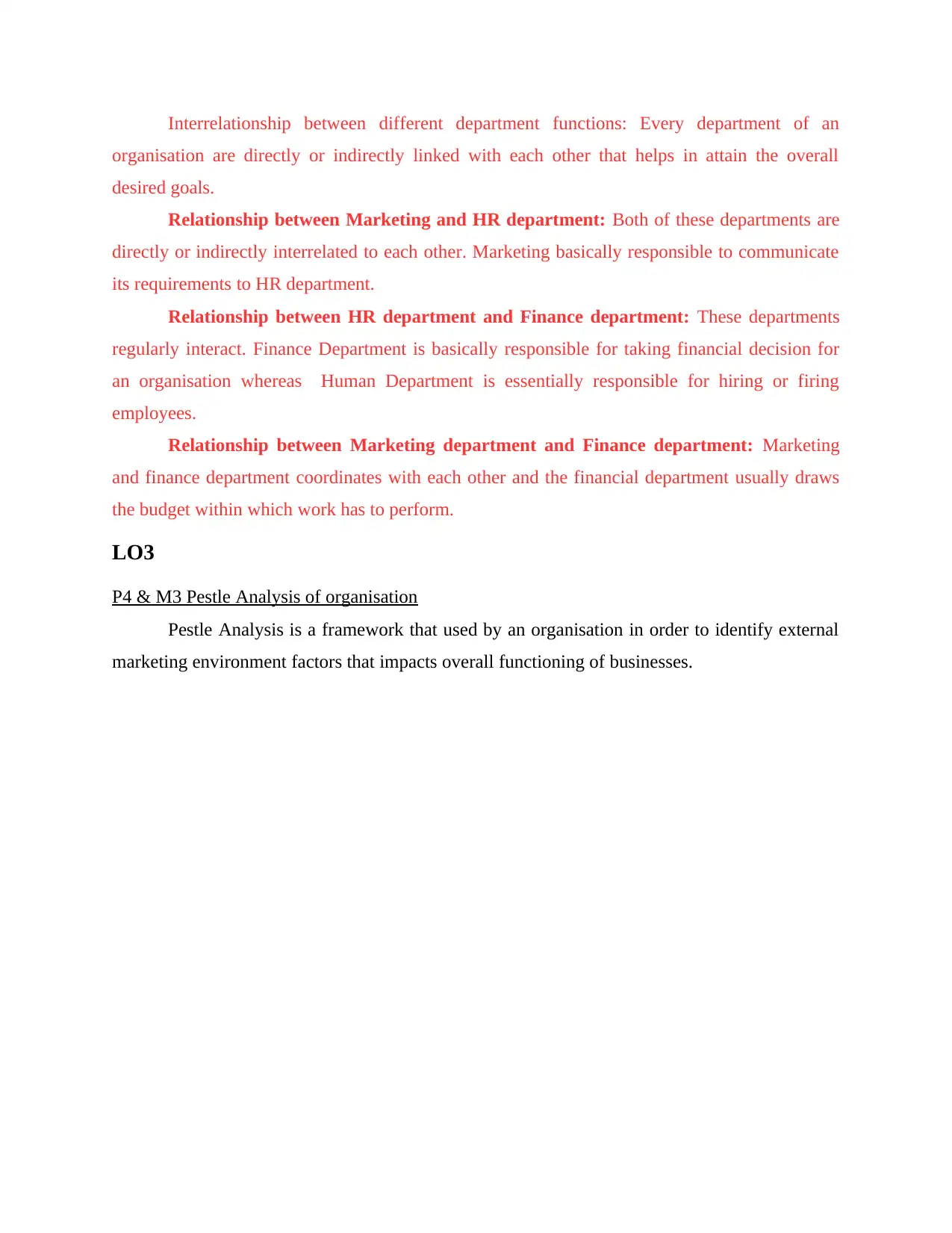
Interrelationship between different department functions: Every department of an
organisation are directly or indirectly linked with each other that helps in attain the overall
desired goals.
Relationship between Marketing and HR department: Both of these departments are
directly or indirectly interrelated to each other. Marketing basically responsible to communicate
its requirements to HR department.
Relationship between HR department and Finance department: These departments
regularly interact. Finance Department is basically responsible for taking financial decision for
an organisation whereas Human Department is essentially responsible for hiring or firing
employees.
Relationship between Marketing department and Finance department: Marketing
and finance department coordinates with each other and the financial department usually draws
the budget within which work has to perform.
LO3
P4 & M3 Pestle Analysis of organisation
Pestle Analysis is a framework that used by an organisation in order to identify external
marketing environment factors that impacts overall functioning of businesses.
organisation are directly or indirectly linked with each other that helps in attain the overall
desired goals.
Relationship between Marketing and HR department: Both of these departments are
directly or indirectly interrelated to each other. Marketing basically responsible to communicate
its requirements to HR department.
Relationship between HR department and Finance department: These departments
regularly interact. Finance Department is basically responsible for taking financial decision for
an organisation whereas Human Department is essentially responsible for hiring or firing
employees.
Relationship between Marketing department and Finance department: Marketing
and finance department coordinates with each other and the financial department usually draws
the budget within which work has to perform.
LO3
P4 & M3 Pestle Analysis of organisation
Pestle Analysis is a framework that used by an organisation in order to identify external
marketing environment factors that impacts overall functioning of businesses.
⊘ This is a preview!⊘
Do you want full access?
Subscribe today to unlock all pages.

Trusted by 1+ million students worldwide
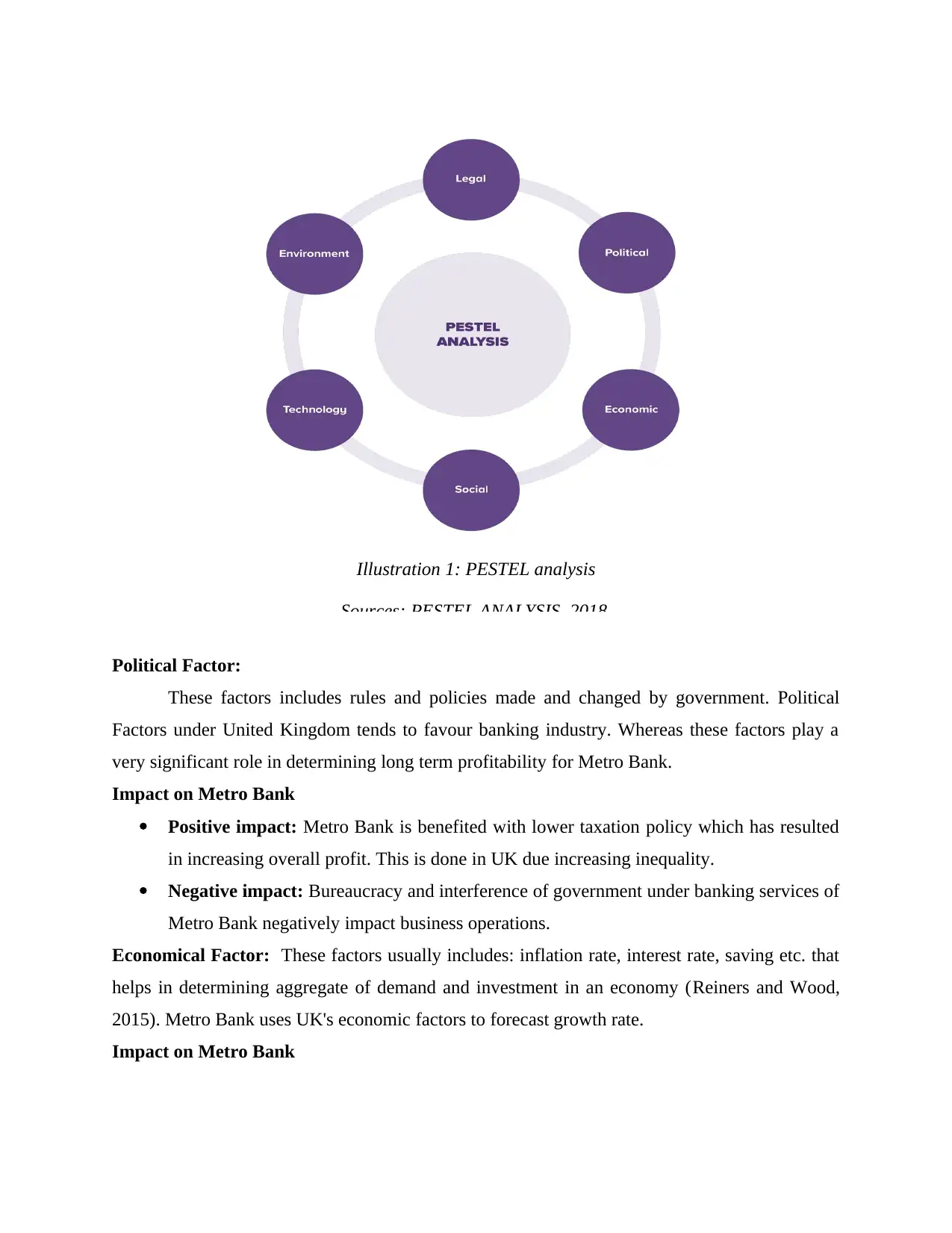
Political Factor:
These factors includes rules and policies made and changed by government. Political
Factors under United Kingdom tends to favour banking industry. Whereas these factors play a
very significant role in determining long term profitability for Metro Bank.
Impact on Metro Bank
Positive impact: Metro Bank is benefited with lower taxation policy which has resulted
in increasing overall profit. This is done in UK due increasing inequality.
Negative impact: Bureaucracy and interference of government under banking services of
Metro Bank negatively impact business operations.
Economical Factor: These factors usually includes: inflation rate, interest rate, saving etc. that
helps in determining aggregate of demand and investment in an economy (Reiners and Wood,
2015). Metro Bank uses UK's economic factors to forecast growth rate.
Impact on Metro Bank
Illustration 1: PESTEL analysis
Sources: PESTEL ANALYSIS, 2018.
These factors includes rules and policies made and changed by government. Political
Factors under United Kingdom tends to favour banking industry. Whereas these factors play a
very significant role in determining long term profitability for Metro Bank.
Impact on Metro Bank
Positive impact: Metro Bank is benefited with lower taxation policy which has resulted
in increasing overall profit. This is done in UK due increasing inequality.
Negative impact: Bureaucracy and interference of government under banking services of
Metro Bank negatively impact business operations.
Economical Factor: These factors usually includes: inflation rate, interest rate, saving etc. that
helps in determining aggregate of demand and investment in an economy (Reiners and Wood,
2015). Metro Bank uses UK's economic factors to forecast growth rate.
Impact on Metro Bank
Illustration 1: PESTEL analysis
Sources: PESTEL ANALYSIS, 2018.
Paraphrase This Document
Need a fresh take? Get an instant paraphrase of this document with our AI Paraphraser

Positive impact: Under UK economy increasing liberalization of trade policy can help
Metro Bank to invest into new regions leading to overall expansion.
Negative impact: Increasing rate of inflation under UK market negatively impacts Metro
Bank because it creates recession in economy.
Social Factor: Social Factors usually includes culture that an organisation needs to adopt.
Therefore, Metro Bank have to understand needs of customers living under UK in order to carry
out business operations with efficiency.
Impact on Metro Bank
Positive impact: Level of education under UK economy is high especially for Metro
Bank. This can help Metro Bank to leverage and expand its presence in UK.
Negative impact: Demographic of population under UK market impacts Metro bank.
Technological Factor: This factor deals with technology and techniques that has been adopted
by an organisation in order to carry out its business operation (Bonamigo, Ferenhof and
Forcellin, 2016). Advancement of technology plays crucial role for Metro Bank.
Impact on Metro Bank
Positive impact: Technology adopted by Metro bank has gain competitive advantage
that has directly lead to stay ahead in market.
Negative impact: Cost of adopting advance technology is usually very high and time
consuming because every technique adopted is revalued.
Legal Factor: This basically deals with legal laws that includes consumer law, employment
legislation etc.
Impact on Metro Bank
Positive impact: Discrimination law introduced by government helps Metro bank to
protect employees and ensure everyone is treated fairly and given same opportunities.
Negative impact: Intellectual property rights and patents protection under UK market
has negatively impacted Metro Bank (Castaneda, 2017).
Environmental Factor: Environmental Factor comprises of many aspects which have direct and
indirect impact over the organisation. In comparison to past days there is huge amount of
preference of application of paperless technology. In consideration with Metro bank organisation
doesn't have much consumption of digital aspects to perform their functions. After that
Metro Bank to invest into new regions leading to overall expansion.
Negative impact: Increasing rate of inflation under UK market negatively impacts Metro
Bank because it creates recession in economy.
Social Factor: Social Factors usually includes culture that an organisation needs to adopt.
Therefore, Metro Bank have to understand needs of customers living under UK in order to carry
out business operations with efficiency.
Impact on Metro Bank
Positive impact: Level of education under UK economy is high especially for Metro
Bank. This can help Metro Bank to leverage and expand its presence in UK.
Negative impact: Demographic of population under UK market impacts Metro bank.
Technological Factor: This factor deals with technology and techniques that has been adopted
by an organisation in order to carry out its business operation (Bonamigo, Ferenhof and
Forcellin, 2016). Advancement of technology plays crucial role for Metro Bank.
Impact on Metro Bank
Positive impact: Technology adopted by Metro bank has gain competitive advantage
that has directly lead to stay ahead in market.
Negative impact: Cost of adopting advance technology is usually very high and time
consuming because every technique adopted is revalued.
Legal Factor: This basically deals with legal laws that includes consumer law, employment
legislation etc.
Impact on Metro Bank
Positive impact: Discrimination law introduced by government helps Metro bank to
protect employees and ensure everyone is treated fairly and given same opportunities.
Negative impact: Intellectual property rights and patents protection under UK market
has negatively impacted Metro Bank (Castaneda, 2017).
Environmental Factor: Environmental Factor comprises of many aspects which have direct and
indirect impact over the organisation. In comparison to past days there is huge amount of
preference of application of paperless technology. In consideration with Metro bank organisation
doesn't have much consumption of digital aspects to perform their functions. After that
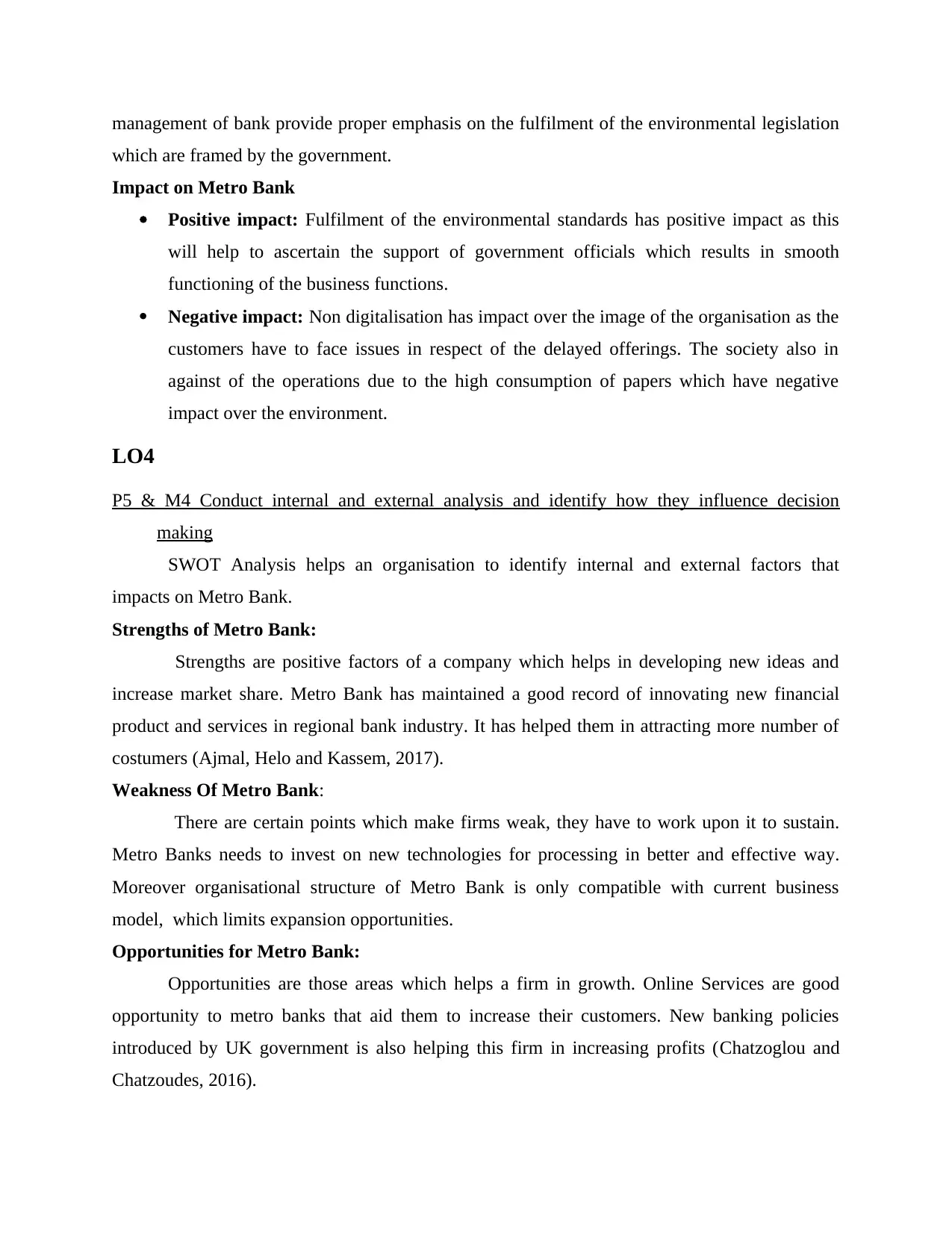
management of bank provide proper emphasis on the fulfilment of the environmental legislation
which are framed by the government.
Impact on Metro Bank
Positive impact: Fulfilment of the environmental standards has positive impact as this
will help to ascertain the support of government officials which results in smooth
functioning of the business functions.
Negative impact: Non digitalisation has impact over the image of the organisation as the
customers have to face issues in respect of the delayed offerings. The society also in
against of the operations due to the high consumption of papers which have negative
impact over the environment.
LO4
P5 & M4 Conduct internal and external analysis and identify how they influence decision
making
SWOT Analysis helps an organisation to identify internal and external factors that
impacts on Metro Bank.
Strengths of Metro Bank:
Strengths are positive factors of a company which helps in developing new ideas and
increase market share. Metro Bank has maintained a good record of innovating new financial
product and services in regional bank industry. It has helped them in attracting more number of
costumers (Ajmal, Helo and Kassem, 2017).
Weakness Of Metro Bank:
There are certain points which make firms weak, they have to work upon it to sustain.
Metro Banks needs to invest on new technologies for processing in better and effective way.
Moreover organisational structure of Metro Bank is only compatible with current business
model, which limits expansion opportunities.
Opportunities for Metro Bank:
Opportunities are those areas which helps a firm in growth. Online Services are good
opportunity to metro banks that aid them to increase their customers. New banking policies
introduced by UK government is also helping this firm in increasing profits (Chatzoglou and
Chatzoudes, 2016).
which are framed by the government.
Impact on Metro Bank
Positive impact: Fulfilment of the environmental standards has positive impact as this
will help to ascertain the support of government officials which results in smooth
functioning of the business functions.
Negative impact: Non digitalisation has impact over the image of the organisation as the
customers have to face issues in respect of the delayed offerings. The society also in
against of the operations due to the high consumption of papers which have negative
impact over the environment.
LO4
P5 & M4 Conduct internal and external analysis and identify how they influence decision
making
SWOT Analysis helps an organisation to identify internal and external factors that
impacts on Metro Bank.
Strengths of Metro Bank:
Strengths are positive factors of a company which helps in developing new ideas and
increase market share. Metro Bank has maintained a good record of innovating new financial
product and services in regional bank industry. It has helped them in attracting more number of
costumers (Ajmal, Helo and Kassem, 2017).
Weakness Of Metro Bank:
There are certain points which make firms weak, they have to work upon it to sustain.
Metro Banks needs to invest on new technologies for processing in better and effective way.
Moreover organisational structure of Metro Bank is only compatible with current business
model, which limits expansion opportunities.
Opportunities for Metro Bank:
Opportunities are those areas which helps a firm in growth. Online Services are good
opportunity to metro banks that aid them to increase their customers. New banking policies
introduced by UK government is also helping this firm in increasing profits (Chatzoglou and
Chatzoudes, 2016).
⊘ This is a preview!⊘
Do you want full access?
Subscribe today to unlock all pages.

Trusted by 1+ million students worldwide
1 out of 16
Related Documents
Your All-in-One AI-Powered Toolkit for Academic Success.
+13062052269
info@desklib.com
Available 24*7 on WhatsApp / Email
![[object Object]](/_next/static/media/star-bottom.7253800d.svg)
Unlock your academic potential
Copyright © 2020–2025 A2Z Services. All Rights Reserved. Developed and managed by ZUCOL.




